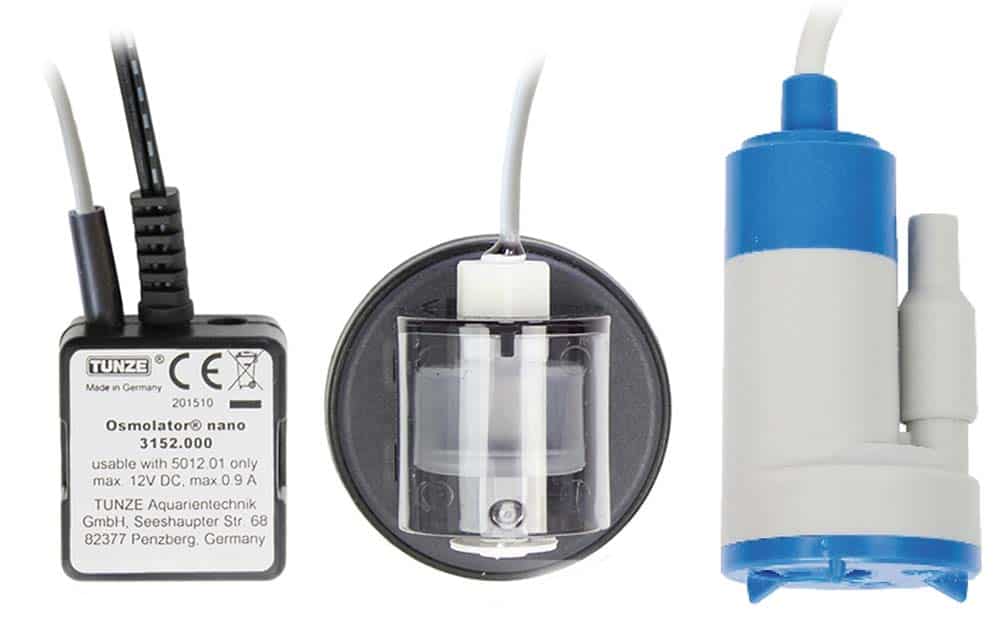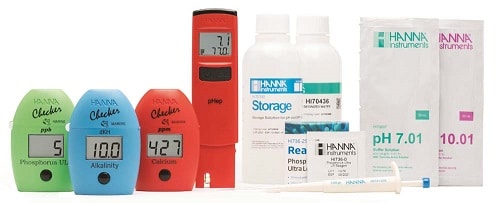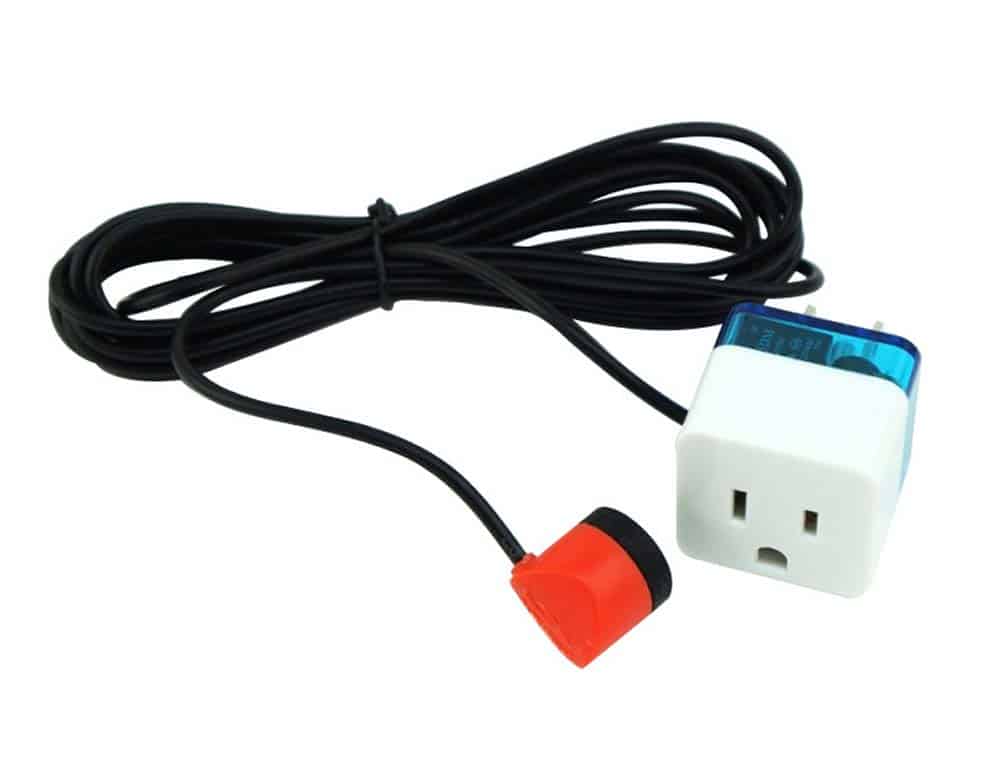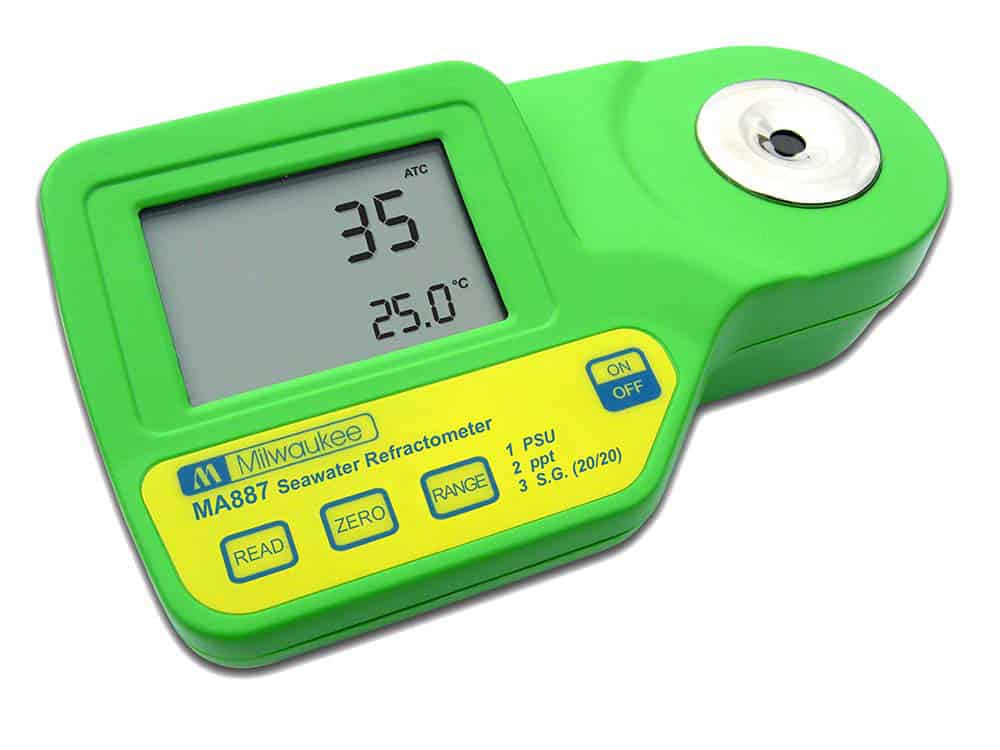Here are 5 must-have reef tank accessories!
- Automatic Top Off (ATO): Automates the task of topping off your tank with fresh water from evaporation.
- Digital Testing: Saltwater digital checkers produce the most accurate test results to help keep your fish and corals healthy.
- Smart Tank Protection: Avoid tank crashes from heater malfunctions and overflowing skimmer caps.
- Automatic Feeder: Automate fish feedings when you are away, or even regular feedings for convenience.
- Refractometer: Get accurate salinity readings quickly and hassle-free. Quit using a hydrometer!
Automatic Top Off (ATO)
The first, best accessory you can add to your reef tank is an auto top off! If you take your reefing seriously, you know the importance of maintaining a constant water level in your aquarium and sump.
A constant water level helps keep consistent water chemistry related to salinity. Consistency in water chemistry is the hallmark of a successful reef tank. After all, an aquarium is simply a box of water when you think about it.
When a saltwater aquarium evaporates water, the salt is left behind, increasing the overall salinity. An automatic top-off regularly adds freshwater back into the tank to maintain the proper salinity levels.
Auto top-off systems will normally include a controller that connects to one or more sensors and then a connection for a pump to transfer the water from a reservoir to your aquarium. The reservoir will be sized relative to your aquarium and typically hold 5 or 10 gallons of fresh water.
The sensors in your tank will sense the water level, and when it drops low enough to trip the sensor, the pump will turn on, pumping freshwater into your aquarium until the pre-set level is reached.
The best stand-alone auto top-offs are generally recognized to be the Tunze Osmolator ATOs. Depending on your tank’s size, you can get the Nano 3152 for smaller tanks up to 55 gallons. Model 3155 is for tanks over 55 gallons.
We recommend going with the Tunze Osmolator 3155 ATO even if you have a tank as small as 30 gallons. The larger 3155 model just seems to have a little better track record for durability than its smaller brother, the Nano 3152. So we differ from the manufacturer on that recommendation, but I’m sure you will be happy with either choice.

Digital testing / Saltwater checkers
The most important parameters to monitor in a reef tank for good coral growth and health are calcium, alkalinity, nitrates, and phosphates.
- Alkalinity: Alkalinity testing is important. It is so important that many aquarists test for it daily.
- Calcium: Corals and coralline algae require calcium for calcification and growth. Some invertebrates like Turbo snails, for example, require calcium to live and grow.
- Phosphates: Excessive phosphate levels can prevent calcification, skeletal formation, and corals growth, particularly those referred to as SPS or small-polyp stony. High phosphate levels can cause nuisance algae growth in your reef tank.
- Nitrates: While insufficient nitrates can starve coral, excess nitrates will lead to an overgrowth of nuisance algae. Managing nitrates and phosphates are key to coral and invertebrate health and controlling nuisance algae.
Testing routinely for each of these parameters can be very time-consuming. Testing is complicated. Parameter testing has multiple steps that include measuring powders and liquids, mixing, and timing each step. Each of these steps is an opportunity to introduce human error into the equation and ruin the test’s accuracy.
For most tests, once the water sample and testing powders or liquids are mixed, it creates a tinted water sample that you are supposed to view compared to a color chart. You have to worry about the lighting in the room, viewing angles, etc. Deciding what shade in the color chart the sample matches is often a toss-up.
Using a digital colorimeter-style test kit ensures that these tests can be completed in less time, and the readings can be repeated time and time again without relying on the human eye to match colors.

Each test only takes a couple of minutes, and when it is finished, the results are shown on a large LCD that is clear and easy to read.
Smart Tank Protection
Smart Temperature Security: Keep your aquarium safe from heater malfunctions with an easy-to-use plug-and-play monitor.
Temperature spikes are a death knell for sensitive ecosystems like a reef aquarium. Heaters are known to frequently last no more than the manufacturer’s warranty period of 1 year—many of them malfunction even faster than that.
An aquarium heater can break and become set in the ‘on’ or ‘off’ state. An overheated tank is one of the fastest ways to crash your tank and kill all of your livestock. If your heater dies set ‘on,’ it will be less than a couple of hours until your tank is toast – literally. If the heater breaks in the ‘off’ position, it will take much longer to cool to deadly levels – but the result will be the same.
Smart monitors for aquarium heaters and chillers are a great reef tank accessory to add to your tank. They have sensors and an outlet that you plug your heater or chiller into. The monitor will use a temperature sensor to watch a temperature safe zone.
The safe temperature zone is normally between 84 degrees F and 72 degrees F. The included outlet will shut off, and an alarm will sound if the tank temperatures dip or spike outside the safe range. You can read more or purchase it here!

Smart skimmer overflow protection: Keep your skimmer from overflowing with this great reef tank accessory that comes with an outlet for your protein skimmer and a contactless optical sensor to detect water levels in the skimmer cup. There are no moving parts to fail.
The magnetically coupled sensor makes it super easy to install and adjust the protein skimmer collection cup’s desired level. There is no need to purchase a new lid or make any modifications to the collection cup. As the level in the cup goes too high, Smart Skimmer Security will shut down the skimmer immediately to prevent your skimmer from overflowing. The auto time delay function prevents false alarms due to power outages. You can read more and purchase the smart skimmer protection here.
Automatic Fish Feeder
Having a reef aquarium has all the responsibilities of any other pets we own. The fish, invertebrates, and corals all need daily care – even if it is just monitoring that all is well with the tank.
Trying to go on a vacation with a reef tank at home usually requires someone you trust to watch it while you are gone. Automatic fish feeders take a little bit of that worry away. Additionally, you can also use them day in and day out for routine feedings if your schedule doesn’t mesh with feeding time.
Automating your fish feedings can definitely make life easier for the aquarist. Fish feeders can be set to feed your fish once or multiple times each day. Some even come with the option of connecting multiple feeders to feed multiple food types.
The automatic fish feeders will deliver dry food such as flakes and pellets. They are not compatible with fresh or frozen feed.
Automatic feeders can also provide meals at the touch of a button if you want to give your fishes a snack between meals. Aquarium controller units power some automatic fish feeders, and some are stand-alone and are battery-powered.
If you already have an aquarium controller system, such as Neptune’s Apex, for example, you can add their automatic feeder simply by plug and play. Neptune’s AFS feeder is about $100 and is designed specifically for use with Neptune Apex Systems.
You can get the Neptune automatic feeding system (AFS) here.
Absent an expensive controller system; a stand-alone battery feeder may be your ticket to peace of mind. If you are only going to be using an auto feeder from time to time, a battery-powered unit will be sufficient.

The Zacro CY-009 Automatic Fish Feeder is great and less than $25.00
Our recommended fish feeder is the Zacro automatic fish feeder. Not only does it perform well and is highly rated, but it is also very inexpensive. Here are some advantages to the Zacro fish feeder.
- The feeder can be programmed for up to 4 feeding times per day.
- Each scheduled feeding can drop food 1-3 times to adjust meal sizes.
- It has a large food barrel that can hold 200 mL of flakes or pellets.
- The feeder has a manual feed button for any time feeding.
- The built-in battery is lithium rechargeable with a standard USB, and a full charge should last 3 to 6 months depending on feeding frequency.
- Large digital display and buttons with easy programming.
- The rotatable mounting bracket fits glass up to 3/4 inch thick.
Refractometer
Accurate testing is critical to maintaining the proper salinity in your saltwater reef tank. The best way to do that is to test your salinity levels with a refractometer routinely.

A seawater refractometer uses the refraction of light in liquid to measure specific gravity. Place a few drops of water under the refractometer lid, close the lid, and point it at a light source. Look through the eyepiece for a change in color created by refracted light. The line will run through a chart inside the eyepiece (see photo above) that indicates the specific gravity.
One of the early mistakes new aquarists make is purchasing a cheap hydrometer when they first get into the hobby. They are inaccurate and essentially plastic trash. Please don’t do it! The most common reason for errors with the hydrometer is air bubbles on the swingarm raise it to indicate higher salinity than is actually present.
Additionally, if not carefully washed after each use, salt can build up in the hydrometer which will affect later test results.
Refractometers are available at your local fish store and online in a variety of price ranges. Typically even the cheapest refractometer works 100 times better than a hydrometer. Amazon.com has a couple of models for under $40.

Digital Refractometer: A digital refractometer is even more precise than a mechanical refractometer. If you want to really ramp up your testing accuracy above most hobbyists, you can purchase a digital refractometer for $115.00. Check it out here.